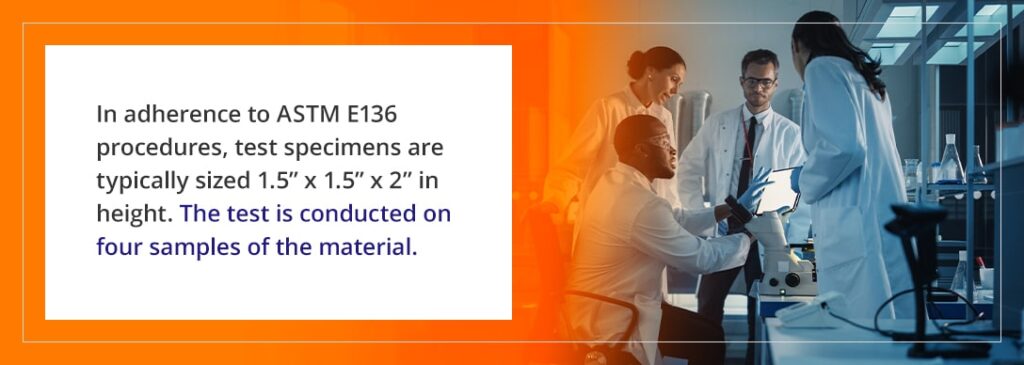ASTM E136 Test
What Is ASTM E136? Assessing the Combustibility of Materials
Companies in the construction and engineering sector must adhere to numerous regulations for their work and the materials they employ to comply with industry standards. One of the most utilized standards involves determining which materials may be U.L. listed and/or recognized as noncombustible building materials. The accepted way for materials to be recognized as such is through the “Standard Test Method for the Behavior of Materials in a Vertical Furnace at 750 degrees Celsius — commonly referred to as ASTM E136.
Many standards require the use of noncombustible materials, including the International Building Code and the International Residential Code. As such, material manufacturers, engineers and construction workers must use tests like ASTM E136 when deciding on materials used in construction and buildings.
ASTM E136 Testing Scope
This testing method involves exposing materials to 750 degrees Celsius to determine whether the material is noncombustible. The materials must last in a furnace for 30 minutes to be considered noncombustible under ASTM E136 standards. This test doesn't duplicate conditions of a building fire — it indicates which materials won't encourage combustion or add heat to a fire.
Typically, any materials that pass material testing using a vertical tube furnace are classified as noncombustible. ASTM E136 testing applies to most building materials, excluding coated or laminated materials, or materials that flow, swell or bubble, melt, soften or separate. This testing method is often used for materials like cement, brick, plaster, cladding, adhesives, flooring, wallboard, insulation and various other building materials.

This test method strictly determines building materials' combustibility under specific, controlled laboratory conditions. ASTM E136 does not quantitatively measure heat generation, self-heating tendencies or intrinsic properties of materials.
ASTM E136 Test Procedures
At VTEC Laboratories — a leading ASTM E136 test lab — we fully respect the importance of this test and what its results mean to your business and the subsequent safety of those who rely on the exclusive use of noncombustible building materials. What follows is a transparent explanation of the procedures of this test and how VTEC helps get you the compliant results you need promptly.
In adherence to ASTM E136 procedures, test specimens are typically sized 1.5” x 1.5” x 2” in height. The test is conducted on four samples of the material. Before testing, the samples are placed in an oven for 24 hours and heated to 60 degrees Celsius. To register accurate test results, two thermocouples — one on the outside and one in the center — are attached to the specimen.
Once appropriately heated and instrumented, the specimen is inserted into a refractory tube with a 3” diameter. A surrounding heating coil then brings the furnace up to temperature, where it remains with the help of airflow stabilizers. The other furnace option involves a ceramic tube with an electric heating coil and refractory tubes. The option used may depend on the specific material or testing agency. Both options use temperatures of 750 degrees Celsius and run for 30 minutes or until failure occurs.
After testing in the furnace, the samples are inspected for desired results.
ASTM E136 Results
For materials to be listed as noncombustible — in other words, by ASTM E136 standards to not aid in combustion or appreciably add heat to a surrounding fire — either one of the two following test results must be found in a minimum of three out of four identical test pieces:
- The weight loss of the specimen piece after the test cannot exceed 50 percent of its original weight. Also, neither its surface nor internal temperature can exceed 30 degrees Celsius above the furnace’s temperature, and there cannot be flaming from the piece after the first 30 seconds of the test.
- If the weight loss of the specimen piece after the test is more than 50 percent of its original weight, then neither its surface nor its internal temperature can exceed the furnace’s temperature, and there cannot be flaming from the piece anytime during the test.
The second test result is directly aimed at materials like concrete and gypsum that can lose substantial weight due to water loss but do not aid combustion or flame during the test.
Related Flammability Tests
To get a more comprehensive view of a material's flammability or combustion, additional tests can help tell the full story. While the best tests will depend on what material you're having tested, here are a few tests you may consider starting with:
- ASTM D635: This test measures the burn rate and the burn characteristics of plastic materials.
- ASTM E119: The ASTM E119 test is one of the most common, measuring the flammability of construction materials and furniture items. This test gradually increases the temperature to determine how easily items are set on fire.
- ASTM E162: This testing method uses radiant heat to determine surface flammability. Results depend on how a material's surface reacts to a fire's radiant heat.
- NFPA 259: Per standards from the National Fire Protection Association, this test measures the heat resistance of building materials.
All fire safety and flammability tests have inherent risks, making it essential to limit risks and leave the testing to a trusted lab like VTEC. Our staff is trained to follow strict testing procedures to ensure you get accurate results the first time your materials are tested. We'll help you stay compliant with any required flammability tests so you're confident your building materials are safe for use.
The VTEC Difference: Cost-Effective Commercial Testing Since 1982
For the best service in cost-effective flammability and materials commercial testing — including ASTM E136 — you want VTEC Laboratories. Our highly trained staff and state-of-the-art equipment make us an industry-leading test lab, and our commitment to our customers means you’ll always get reliable results when you need them. We're certified to perform ASTM E136 tests and various others, including those listed above. If you need a test you can't find on our website, let us know your needs so we can help you find a solution.
To learn more about ASTM E136 or for a free consultation, fill out our contact form or call 718-542-8248 today.
Recommended Tests to Pair with ASTM E136:
- ASTM D2843 - Smoke Density Test
- ASTM E119 - Fire Tests of Building Construction & Materials
- ASTM E84 - Surface Burning Test for Building Materials
- UL1479 - Firestop System Test
- UL1709 - Fire Test of Protection Materials for Structural Steel
Learn More About VTEC Services
At VTEC Laboratories, our role as a multi-functional company stems from our more than three decades of experience. Due to our extensive expertise in multiple industries, we provide comprehensive services that meet each field’s unique standards, needs and objectives.
Learn more about our services by contacting us online or calling us at (718) 542-8248.

